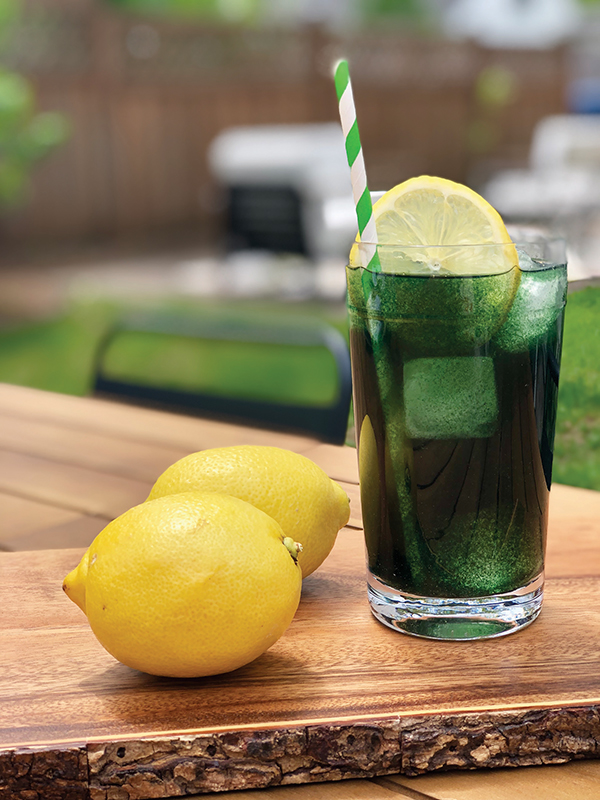HEALTHY LIVING
Mandy Moore’s mindful tips for a well-balanced, lively summer

(Family Features) With plans of trips and relaxation on the horizon, it can be easy to give your wellness routine a vacation, too. Before you jet set off on your next adventure, take a moment to be consciously aware of how your mind and body may react to an overly active and jam-packed summer schedule.
“As someone with a busy lifestyle, having an intentional, balanced wellness routine helps me be my best self for my job, my friends and my family,” said actress and wellness advocate Mandy Moore.
Partnering with Nature’s Way to celebrate its 50th birthday, Moore shares a passion for paving a better way to wellness. While no single trick or technique guarantees well-rounded health, it’s really about establishing habits that work best for you and your lifestyle. Your routine may often change daily depending where you are on your wellness journey, but Moore shares thoughtful considerations to always keep in mind:
1. Start from Within. It’s important to understand the connection between your mind and body.
“I recognize it takes time, trust and baby steps, but the outcome is incredibly rewarding,” Moore said. “I’m a strong believer in the power of therapy and find my most important work is done during the moments when I feel like I’m operating at 100 percent.”
She also recommends downloading a meditation app, calling a friend or writing in a journal to help balance a hectic summer schedule.
2. Seek New Ways to Nourish Your Body. Wellness goes beyond simply what you put on your plate. Listening to your body can help you go the extra mile, especially when you’re traveling, which is why Moore takes Alive! Women’s Energy from Nature’s Way, packed with 16 different health-benefiting vitamins and minerals.
Drinking water-based beverages is a big piece of her wellness routine, as well. She loves relaxing with tea sourced from around the globe and drinking water with liquid chlorophyll for an internal refresher.
3. Breathe in the Sights, Scents and Sounds of Nature. In today’s fast-paced world, it’s important to take time to breathe; to take in nature’s true beauty. Watch a sunset, walk through a park or get away from the city lights so you can really see the stars shine. Be more proactive this summer and immerse yourself in environments that truly allow you to feel renewed.
Moore loves to go hiking and walks her dogs, Jackson and Joni, each day.
“There’s something that’s innately healing about feeling connected to the ground – feeling grounded, literally, to the world around you,” Moore said.
4. Unplug to Recharge. Even if your schedule constantly keeps you on the go, it’s important for your mental health and well-being to take time to unplug and find different ways to clear your mind.
“Take moments to step away from the computer, tablet or phone – put it in the other room, let it charge and do something else constructive for your brain,” Moore said. “Pick up a book, put on an album, call a friend, light a candle and decompress. I’m a big proponent of smell; sense therapy is really helpful for me. One of the first things I do when I get home is light a candle.”

Summer Travel Advice
According to an AAA Travel survey, nearly 100 million Americans – 4 in 10 U.S. adults – are planning to take a family vacation in 2019, slightly more than last year, with road trips topping many vacationers’ plans. Before you depart from reality, take a moment to ensure you and your loved ones are fully prepared with these tips.
Pack Your Patience
Be prepared for busy roads and long airport security lines throughout the summer. Bring books, games or music for the ride to keep kids and other passengers entertained. Pack healthy snacks for kids, especially if you can’t fit in a full meal while traveling, and don’t forget to pack a pillow as well as information on your destination.
Take Preventative Measures
Air travel, especially on international flights, can be stressful and lead to extra strain on your physical and psychological health. Fatigue, increased stress and mental changes have also been reported during and after long-distance flights, according to the U.S. National Library of Medicine. Take time to make sure your immune system is functioning at its best.
A study published in “Nutrients,” found air travelers taking capsules containing elderberry extract before and during their trips experienced an improved immune system response versus travelers who were given a placebo.
Elderberry extract is available in a variety of travel-friendly formats. For example, Nature’s Way, a pioneer in the health industry, offers Sambucus Elderberry Zinc Lozenges and Gummies, which can be found at most health and wellness retailers. Be sure to ask your health care provider for advice when adding a new supplement to your diet.
Break a (Free) Sweat
These days, many hotels and resorts offer on-site fitness rooms, but they may not always have your preferred equipment and machinery. If you decide to hit the gym, you may be able to score a free day pass. A lot of chain gyms, and even some local operations, may offer free, one-day trial experiences. With a little research in advance of your trip, you can ensure your fitness routine doesn’t go out the window simply because you’re away from home.

For more ways to take care of your body and mind this summer, visit 50.naturesway.com.
Cool Off with Chlorofresh
Servings: 1
- 8 ounces lemon water
- 1 squeeze fresh lemon juice
- 1/2 teaspoon ground ginger
- 1 pinch salt
- 1 teaspoon Nature’s Way Chlorofresh Liquid Chlorophyll (unflavored)
- Mix lemon water, lemon juice, ground ginger, salt and unflavored chlorophyll liquid. Serve over ice.
Photo courtesy of Getty Images (woman looking out to sea)
SOURCE:
Nature’s Way
HEALTHY LIVING
Save a life from stroke

(Family Features) Strokes can happen to anyone, at any age – even young people. Despite being one of the leading causes of death and long-term disability in the United States, strokes are largely preventable, treatable and beatable – if you can control your risk factors.
According to the American Stroke Association, a division of the American Heart Association, every 40 seconds, someone in the U.S. has a stroke. Keeping blood pressure in check, living a healthy lifestyle and knowing stroke warning signs may help protect you and your loved ones.
Here are key insights from the American Stroke Association’s Together to End Stroke initiative, nationally supported by the HCA Healthcare Foundation.
Controlling Risk Factors
Up to 80% of strokes may be preventable, according to the American Stroke Association. You can take action to prevent strokes by managing your risk factors, like high blood pressure, a leading cause and controllable risk factor for stroke and heart disease.
Other risk factors include diabetes and obesity, which can be kept in check with healthy lifestyle behaviors such as good nutrition. Quitting smoking and being physically active are important. Atrial fibrillation, or AFib, which is a quivering or irregular heartbeat, also increases stroke risk. In fact, people with AFib are five times more likely to have a stroke, according to the American Heart Association.
Preventing a Second Stroke
Nearly 1 in 4 strokes occur in people who had a previous stroke, sometimes because they don’t know what caused the first, making identifying the cause of the stroke a key step toward future prevention. Treatment depends on the type of stroke someone is having, which can be determined with a series of medical evaluations and tests.
Work with your health care professional to develop a plan that helps you move forward after a first stroke while preventing a second. This plan should include controlling risk factors, like achieving and maintaining healthy blood pressure, blood sugar and cholesterol levels.
“Preventing a second stroke is possible with the right approach,” said Teresita Casanova, MD, HCA Healthcare affiliated neurologist and American Stroke Association volunteer expert. “Taking medicines as prescribed, monitoring health numbers, and making small, consistent lifestyle changes can make a big difference. Stroke survivors should feel empowered to take control of their health and work with their care team to build a strong prevention plan.”
To help you in your journey, you can rely on tools such as the Heart & Stroke Helper, a free self-management app available for stroke survivors and their caregivers. The app allows patients to oversee their health in one place with features that track progress on lifestyle habits, manage medications, track health numbers, provide information about stroke and allow patients to connect with others for inspiration.
Find more ways to manage second stroke risk at Stroke.org

Act F.A.S.T.: How to Detect Signs of Stroke
Most adults in the U.S. don’t know the stroke warning signs, nor that stroke is largely treatable if you call 911 as soon as you recognize the symptoms.
Learning the acronym F.A.S.T. can help you recognize that someone may be having stroke symptoms so you can take life-saving action.
F: Face Drooping. Does one side of the face droop, or is it numb? Ask the person to smile. Is the person’s smile uneven?
A: Arm Weakness. Is one arm weak or numb? Ask the person to raise both arms. Does one arm drift downward?
S: Speech. Is speech slurred? Is the person unable to speak or hard to understand? Ask the person to repeat a simple sentence, like “The sky is blue.”
T: Time to Call 911. If you or anyone else shows any of these symptoms, call 911 immediately.
Photo courtesy of Shutterstock
SOURCE:
HEALTHY LIVING
How to conduct a skin care self-exam

Time spent soaking up the summer sun is one of the things that makes the season so appealing. Warm outdoor air has a calming effect that can make anyone feel more relaxed and comfortable.
As good as warm summer sun can feel, overexposure to the sun can be dangerous. The World Cancer Research Fund reports there were more than 330,000 new cases of skin cancer diagnosed across the globe in 2022. A significant percentage of skin cancer cases can be prevented, and prevention is a multifaceted process that includes skin care self-examinations. Self-exams do not take up much time, and individuals can speak with their physicians about how frequently they should check their skin for signs of skin cancer. The U.S. National Library of Medicine offers the following instructions for how to conduct a skin self-exam.
Choose the right time to examine your skin. The USNLM recommends conducting a skin exam after bathing. Women who routinely conduct breast self-exams can check their skin at this time as well.
Use a full-length mirror. ItÕs not always easy to examine skin throughout the body. But signs of skin problems can occur anywhere on the body, including areas that might be hard to see without help. If possible, conduct a self-exam of the skin in front of full-length mirror in a brightly lit room.
Identify what youÕre looking for. The USNLM notes you should be looking for any new skin markings. This includes bumps, moles, blemishes, and changes in skin color.
Pay close attention to preexisting moles. A potential sign of skin cancer includes moles that change over time. Examine preexisting moles to see if they have changed in size, texture, color, and shape.
Look for unusual moles. The USNLM characterizes certain moles as Òugly duckling moles.Ó These unique moles look and feel different from nearby moles and may be indicative of skin cancer. Speak with a dermatologist if a self-exam uncovers the presence of moles with uneven edges or differences in colors or asymmetric shapes. Moles that look different from one side to the other also should be brought to the attention of a dermatologist. Moles that do not stop bleeding or will not heal also merit examination by a skin care professional.
When the time comes to conduct the exam, the USNLM recommends following these steps:
- Look closely at your entire body, both front and back, in the mirror.
- Check under your arms and on both sides of each arm. Be sure to examine the backs of your upper arms, which can be hard to see.
- Bend your arms at the elbow, and examine both sides of your forearm.
- Examine the tops and palms of your hands.
- Examine the front and back of both legs.
- Examine your buttocks and between your buttocks.
- Examine your genital area.
- Examine your face, neck, the back of your neck, and scalp. Use both a hand mirror and full-length mirror, along with a comb, to see areas of your scalp.
- Examine your feet, including the soles and the spaces between your toes.
- Ask a person you trust to help examine hard-to-see areas.
Skin cancer poses a formidable threat, but many cases of the disease are preventable. Routine skin self-exams are a vital component of skin cancer prevention. TF256909
HEALTHY LIVING
What does 100% grass-fed organic dairy bring to your table

(Family Features) It’s no secret that many grocery store dairy sections are filled with more options today. One choice continuing to gain favor with consumers is 100% grass-fed organic dairy. Nutrition, environmental awareness and animal care are some of the leading reasons consumers choose grass-fed dairy products.
Globally, the 100% grass-fed dairy market is projected to continue growing and some market experts predict annual growth rates as high as 22%. If you’re curious about 100% grass-fed organic dairy, consider these benefits from Maple Hill, America’s original 100% grass-fed organic dairy producer. The pioneer of 100% grass-fed organic dairy took its commitment a step further by celebrating and declaring National 100% Grass-Fed Organic Dairy Day on April 15, which recognizes the positive impact it has on consumers, cows, farmers and the environment.
1. Honoring the Farmers
Unlike large-scale corporate dairy farms, most organic farms are small, family-owned operations dedicated to traditional, sustainable farming. Small dairy farms have been disappearing, but 100% grass-fed organic dairy creates a sustainable, viable path forward for farmers who work in harmony with nature.
This more natural approach to dairy is a “craft” process favoring small family farmers who are willing to dedicate the extra focus and patience to a better product and process. These family farms are passed on to future generations to grow the “better for you, better for the planet” approach.
2. Commitment to Good Health
Most consumers don’t know the difference between traditional organic and 100% grass-fed organic dairy. One key distinction is the products’ nutritional composition; 100% grass-fed organic dairy provides a 50% healthier ratio of omega 3:6 and 40% higher levels of CLA fatty acids, which may support heart health and provide other health benefits.
What’s more, Maple Hill’s products made with 100% grass-fed organic dairy are GMO free, hormone free and antibiotic free with no additives or fillers. The line of high-quality, rich-flavored products let you experience the organic difference from traditional dairy for a nutrient-dense solution that tastes as nature intended.
3. Happy, Healthy Cows
Cows on a 100% grass-fed diet can live up to three times as long as grain-fed cows and are never subjected to unnatural diets, hormones or antibiotics. More time in pastures filled with lush grass means cows have the freedom to roam, ruminate and graze on diverse, nutrient-rich grasses.
The result is happier, healthier cows, which in turn results in a richer, better-tasting and more nutrient-dense milk.
4. Sustainability and the Environment
Producing milk without grain or corn requires farmers to focus on regenerating soil and the soil life that supports everything else on the farm. In fact, the healthier the soil, the healthier the feed, so farmers have a natural incentive to be as regenerative as possible. Regenerative grazing practices are a powerful and positive tool to improve land and the web of life on farms by actively restoring soil health, promoting biodiversity and reducing the environmental impact compared to conventional dairy.
Well-managed grazing helps pull carbon from the atmosphere into the soil, fighting climate change in the process. In addition, healthier soil retains more water, reducing runoff and protecting water sources from agricultural pollution.
5. Strengthening the 100% Grass-Fed Organic Market
Consumers are increasingly aware of the choices they have in dairy products and how 100% grass-fed organic supports their health, farmers, animals and the planet. Some ways to support this category’s continued growth include choosing certified 100% grass-fed organic dairy, advocating for regenerative farming and helping shape a more sustainable food system.
Learn more about 100% grass-fed organic dairy products at maplehill.com.
SOURCE:
-

 NEWS3 years ago
NEWS3 years ago2 hurt, 1 jailed after shooting incident north of Nocona
-

 NEWS2 years ago
NEWS2 years agoSuspect indicted, jailed in Tia Hutson murder
-

 NEWS2 years ago
NEWS2 years agoSO investigating possible murder/suicide
-

 NEWS2 years ago
NEWS2 years agoWreck takes the life of BHS teen, 16
-

 NEWS2 years ago
NEWS2 years agoMurder unsolved – 1 year later Tia Hutson’s family angry, frustrated with no arrest
-

 NEWS2 years ago
NEWS2 years agoSheriff’s office called out to infant’s death
-

 NEWS2 years ago
NEWS2 years agoBowie Police face three-hour standoff after possible domestic fight
-

 NEWS3 years ago
NEWS3 years agoDriver stopped by a man running into the street, robbed at knifepoint






